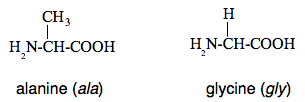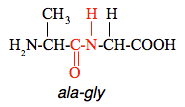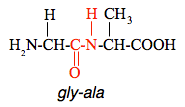|
Chemguide: Support for CIE A level Chemistry Learning outcome 34: Nitrogen compounds 34.4: Amino acids Learning outcome 34.4.2 This statement is about the way amino acids join up producing peptide bonds in di- and tripeptides. You will find what you need on the page about protein structure. You do not need to read the whole of this page. All you need is to go down as far as the second green box. The syllabus talks about the formation of di- and tri-peptides. The page you have looked at has an example of a dipeptide, and then jumps to a polypeptide containing lots of peptide links. A tripeptide would look like this, where the R groups can be any combination of same or different:
Notice that a tripeptide has 3 amino acid residues - not three peptide links. Is this confusing? I think so! To repeat something from the page you read: When you draw these structures, the NH2 group is always written at the left-hand end of the structure that you draw, and the COOH group at the right-hand end. CIE might well ask you to draw a dipeptide or a tripeptide if they give you the structures of the amino acids. In biochemistry, the amino acids are given abbreviations. For example, glycine is gly and alanine is ala. The amino acids alanine and glycine are:
And the dipeptide ala-gly would be:
The dipeptide gly-ala is different:
© Jim Clark 2020 |



